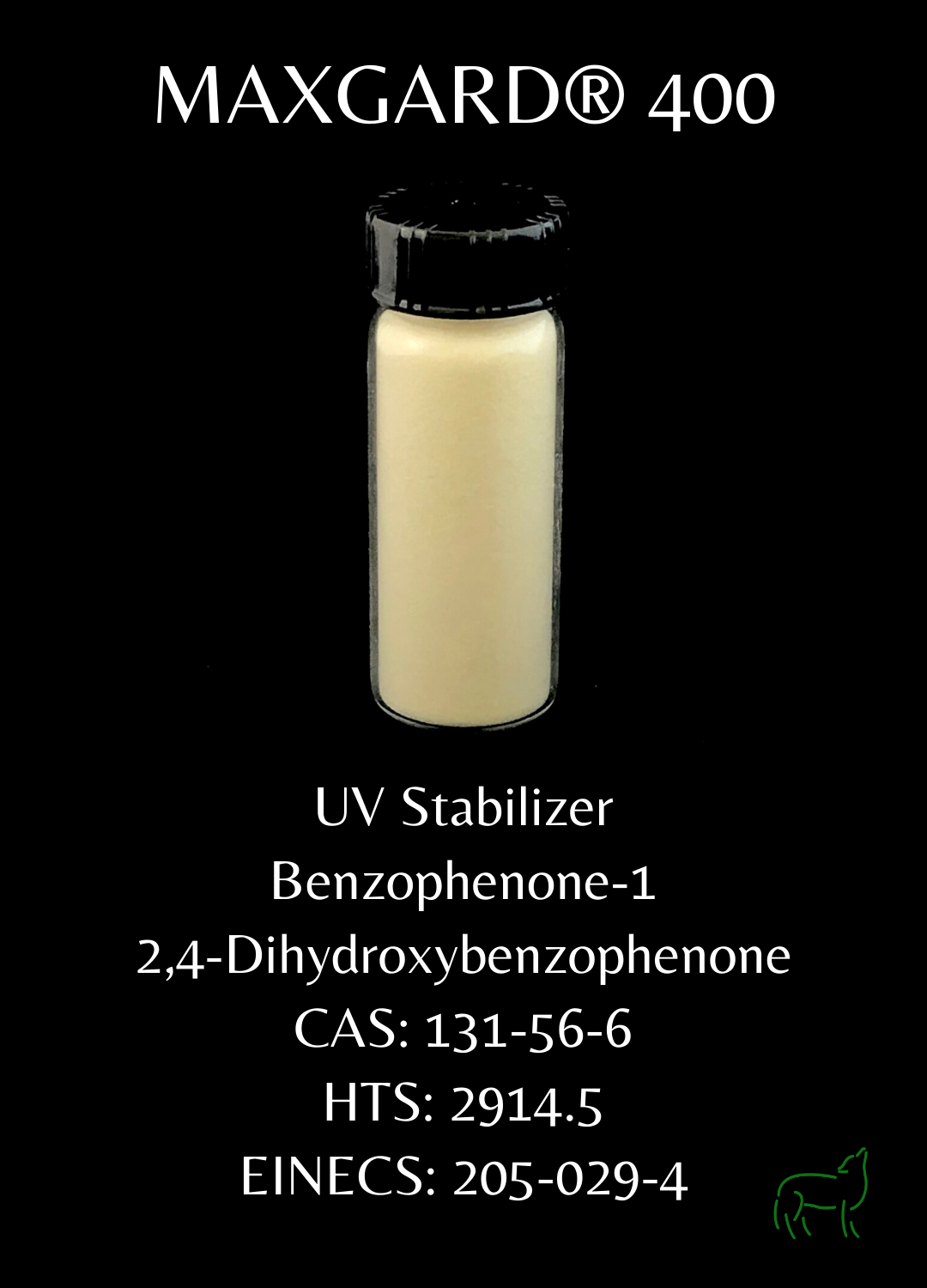Plastic, Coating, & Adhesive Applications
The MAXGARD® UV Absorbers listed below are for use in polymers intended for plastics, inks, textiles, coatings, polyester films and adhesive applications. MAXGARD® UV Protection enhances product performance to meet the needs of our customers. Our product line is particularly effective in protecting against the damaging ultraviolet radiation within the UV-A and UV-B ranges.
*Key is the solubility of the UV absorber in the plasticizers.
**Limited by their concentration range. So it is relative to concentration and polarity and non-polarity of the matrix.
MAXGARD® 600 is an effective 100% active liquid light stabilizer for use in plastics and coatings. It is miscible with a large number of common solvents and plasticizers which makes it easy to incorporate into many systems.
MAXGARD® 2700 is an effective light stabilizer for protecting plastics and coatings from the damaging UV radiation which is a component of natural sunlight. It is very compatible with several polymer materials and is very useful as a UV screen in these products. MAXGARD 2700 has a very broad absorption band which extends into the UV-A range.
MAXGARD® 2800 is an effective light stabilizer for protecting plastics and coatings from the damaging UV radiation which is a component of natural sunlight. It is very compatible with several polymer materials and is very useful as a UV screen in these products. MAXGARD 2800 has a very broad absorption band which extends into the UV-A range.
MAXGARD® 2900 is an effective light stabilizer for protecting plastics and coatings from the damaging UV radiation which is a component of natural sunlight. It is very compatible with several polymer materials and is very useful as a UV screen in these products. MAXGARD 2900 has a very broad absorption band which extends into the UV-A range.
MAXGARD® & The Benefits Of UV Absorbers
For a UV absorber to work, it has to absorb UV light better and faster than the material/surface it is trying to stabilize. Since energy is unable to be destroyed, the UV rays taken in by the UV absorber have to go somewhere. Our products convert the energy from UV radiation into heat. UV absorbers transmit the consumed energy by scattering the heat. By doing this, these absorbers safely release the UV radiation in a way that doesn’t damage the material (s) they protect. It’s crucial that the UV absorber dissipates the absorbed energy before unwelcome side reactions are triggered.
UV absorbers have several different material compositions. These include benzotriazole, a common UV absorber for polyvinyl chloride (PVC), cyanoacrylate, a common absorber for adhesives, and benzophenone, which is commonly used as an ultraviolet absorber for many different types of plastics.
UV light causes deterioration in plastics and rubbers that can change them not only visually, but also cause detrimental influence on a number of physical and mechanical properties. UV absorbers play a crucial role in preserving not only rubbers and plastics, but all kinds of products. They protect surfaces by significantly slowing down the photodegradation process.
The effectiveness of UV absorbers is primarily determined by the Lambert-Beer Law. This law states that the quantity of light absorbed by a substance dissolved in a fully transmitting solvent is directly proportional to the concentration of the substance and the path length of the light through the solution. The mathematical equation for the Lambert-Beer Law is A = εlc. A is absorbance, l is the length of the path light must travel (in centimeters), and c is the concentration of a given solution. In the equation, ε is the molar extinction coefficient. Extinction depends on wavelength and can be referred to as a measure of the stabilizing or screening effect of the UV absorber. Essentially, the higher the extinction, the higher the UV light screening and the greater the stabilizing effect is. This is always assuming that the UV absorber itself was not ruined when the light was absorbed. Extinction is dependent on the extinction coefficient, the film thickness (“d”), of the unpigmented polymers, and the concentration (“c”), of the UV absorber in the polymer.
UV absorbers are not to be confused with blockers. UV absorbers don’t block UV light. They create a physical barrier between the skin and UV rays. The most common blockers are titanium dioxide and zinc oxide. Our products compete with the surface material for the UV radiation from the sun.
UV absorbers have great efficiency in protecting materials from UV damage. Absorbers also have the benefit of protecting against thermal damage. When a project needs protection from the heat, HALS offer both heat and light damage resistance.
Hindered amine light stabilizers, more commonly known as HALS, are a type of light stabilizer. HALS differ from UV absorbers in the fact that UV absorbers take in the ultraviolet light and keep it from reaching the plastic, but HALS have a distinct operation that involves free radicals and chemical reactions. When light hits a surface, it sends energy to the atoms in the plastic. These atoms absorb the energy, which excites their components. This substance takes in alkyl radicals the excited atomic particles produce. The alkyl reacts with the nitroxide to form amino ethers. These ethers then find peroxyl radicals in the material. The amino ethers destroy the peroxyl radicals, and the products of the reaction regenerate the HALS nitroxides. Without neutralizing these alkyl and peroxyl radicals, the material would experience damage through oxidation.
Degradation is a loathsome process that unfortunately occurs in most polymeric applications. It typically leads to changes in both the chemical and physical structure of the polymer, which results in the loss of a number of useful properties. UV degradation of polymers can negatively affect molecular weight, impact resistance, elongation at break, gloss, and color. By integrating UV absorbers, the occurrence of such damages can slow down considerably.
UV absorbers can protect a surface in two ways: by mixing the absorber into the material or through a simple surface coating. Both approaches have their own assets for particular situations. One advantage of coating the surface with only a stabilizing agent mixed with lacquer is that it is a very easy application. In coatings, UV absorbers lessen the damaging effects of the sun. Adding these absorbers to a surface preserves the color brightness and the lifespan of UV-sensitive products. In order to maximize the performance of your UV absorber in the coating, it’s crucial that the additive is completely mixed with the coating. UV absorbers with higher molecular weight have a higher quality performance when used with polar polymers.
UV absorbers work best when used with a thick material because UV absorbers rely on depth as part of their effectiveness. Because UV absorbers vary in their effectiveness depending on thickness, concentration, and formulation, it’s important that you choose the best absorber for your distinct application.
Our Maxgard® products that are UV light absorbers work to protect plastics and coatings from damaging UV radiation. The products we make are applications that customers use to put into another product, and each of our absorbers have unique, effective applications.
Maxgard® 500 is an active ultraviolet light absorber which is used to prevent discoloration caused by sunlight or fluorescent lighting. Maxgard® 1030 provides protection for acrylic, polyester, rubber, polyurethanes, stains and varnishes, nitrocellulose lacquers, fluorescent pigments, and photographic emulsions. Maxgard® 1888’s application is as a UV absorber in cosmetics, hair care products, textiles, and water-based paints and inks to protect product color, fragrance and to protect the polymer that gives gel its structure.




















